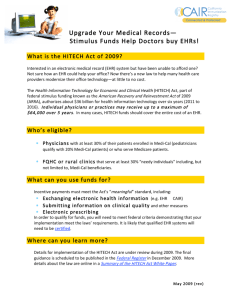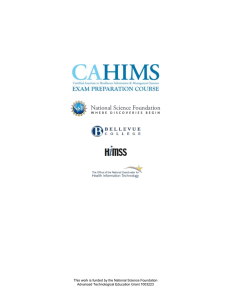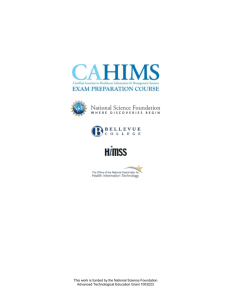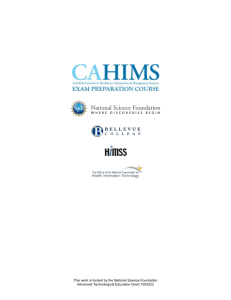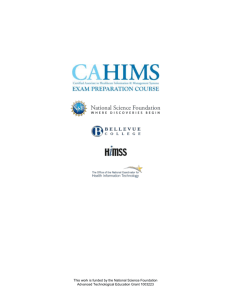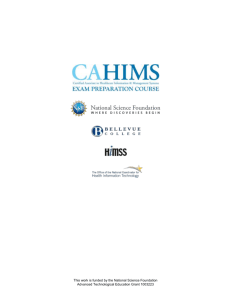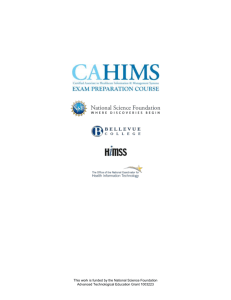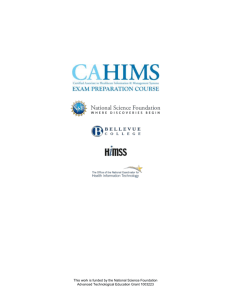4.1-Assessment-Key
advertisement
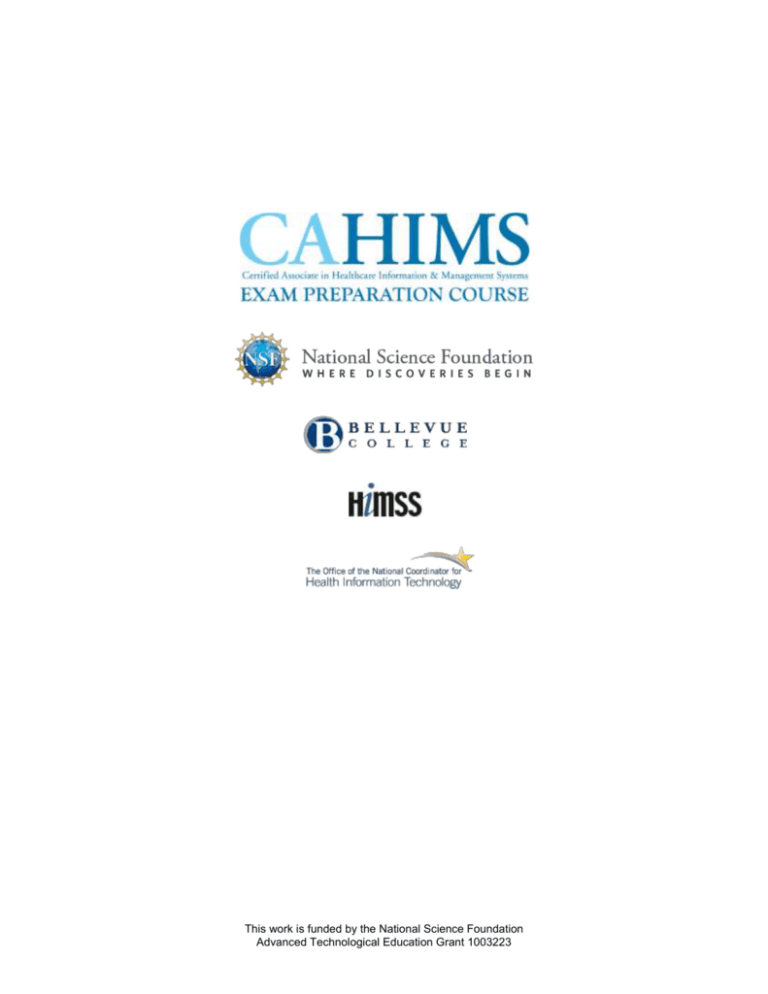
This work is funded by the National Science Foundation Advanced Technological Education Grant 1003223 The CAHIMS Exam Preparation Course and the CAHIMS exam are the result of collaboration between the Life Science Informatics Center at Bellevue College and the Healthcare Information and Management Systems Society (HIMSS). Significant content found in the CAHIMS Exam Preparation Course stems from the Office of the National Coordinator for Health Information Technology. Creation of the CAHIMS Exam Preparation Course and the CAHIMS exam was made possible through support from the National Science Foundation (NSF). Curriculum Team: Margaret Schulte, DBA Michèle Royer, PhD Nathan Savage, MLIS This work is funded by the National Science Foundation Advanced Technological Education Grant 1003223 Section 4 - HIMS Selection and Acquisition Lecture 4.1 - Systems Selection Assessment Questions Answer Key Lecture 1 1. True or false? Business practices may have to be modified for, and workflow often has to be adapted to, the particular design of the COTS product. *a. True b. False Answer: A. True Lecture(s)/Slide(s) 5 2. What is NOT a true statement regarding the CCHIT? a. CCHIT stands for Certification Commission for Health Information Technology. b. CCHIT has partnered with the US Department of Health and Human Resources. *c. It is a government regulatory agency. d. It is becoming increasingly relevant in the EHR arena. Answer: C. CCHIT stands for Certification Commission for Health Information Technology, which is a private nonprofit organization, not a government regulatory agency. Lecture(s)/Slide(s) 8 3. Which is NOT a characteristic of the HITECH Act? a. HITECH Act initially rewards institutions for switching to EHRs. b. Starting in 2015, HITECH imposes penalties for noncompliance. *c. HITECH helps narrow the initial field of vendors. Answer: C. Helping narrow the initial field of vendors is a positive characteristic of certification of EHR systems, not of the HITECH Act. Lecture(s)/Slide(s) 11 This work is funded by the National Science Foundation Advanced Technological Education Grant 1003223 Page 1 4. What is NOT a category of stage 1 meaningful use criteria? a. Improve care coordination b. Improve population and public health *c. Define minimum EHR functionality d. Ensure adequate privacy and security protections for personal health information. Answer: C. Defining minimum EHR functionality is a characteristic of CCHIT certification, not meaningful use criteria. Lecture(s)/Slide(s) 9 5. Which are advantages to using COTS software? a. Development costs are typically lower b. Integrates best with your present IT system components c. Easier learning curve for users and administrators *d. A and C Answer: D. Both A and C are typical advantages to using COTS software. Lecture(s)/Slide(s) 4 6. What is a disadvantage to building your own in-house software solution? a. Fewer software “bugs” incurred b. Shorter development time *c. Training must be developed in house d. A and B Answer: C. In-house software requires the developers to design their own training for their software. Lecture(s)/Slide(s) 7 7. HITECH requires healthcare institutions to switch to some sort of EHR system by this year to avoid financial penalties: a. 2013 *b. 2015 c. 2020 d. 2025 Answer: B. 2015. This work is funded by the National Science Foundation Advanced Technological Education Grant 1003223 Page 2 Lecture(s)/Slide(s) 14 Lecture 2 8. What is one suggestion to consider when forming a EHR selection committee? *a. Invite “movers and shakers” onboard in the decision-making process. b. Invite patients on your committee. c. Exclude as many top administrators as possible since their skill set with regards to EHR systems is often too limited. d. Be sure to limit physician input only to relevant topics such as workflow. Answer: a. Invite “movers and shakers” onboard in the decision-making process. Lecture(s)/Slide(s): 4 9. Functional Requirements can best be defined as: *a. those processes that you want a system to perform. b. the attributes of the system as a whole or its environment. c. the requirements needed for the hardware to function. Answer: a. Functional requirements can best be defined as those processes that you want a system to perform. These can be discussed as an overview or can be analyzed in great detail. Lecture(s)/Slide(s): 8 10. What does HL7 stand for? *a. Health Level 7 b. High Load 7 c. EHR Code of ethics guaranteeing safety Answer: a. Health Level 7. Lecture(s)/Slide(s): 11 11. Which are recommended steps for using HL7 as a baseline for your EHR requirements? a. Learn the language: Understand how key words are used within the model. b. Review and select relevant sections relevant to your healthcare setting. c. Understand that no organizational structure exists to the document as it is meant to be loosely interpreted. This work is funded by the National Science Foundation Advanced Technological Education Grant 1003223 Page 3 *d. Both a and b Answer: d. Both a and b. c is incorrect as the document has a definite hierarchical structure divided into three sections. Lecture(s)/Slide(s): 12-13 12. What is a use case? a. Background information including organization size and specialty and current systems and hardware in place. *b. A technique for documenting the potential requirements of a new system or any type of system change. c. The defined learning curve for users/ administrators. d. Both a and c Answer: b. A technique for documenting the potential requirements of a new system or any type of system change Lecture(s)/Slide(s): 14 13. What is NOT something typically found in a RFP? a. System Implementation plan b. Proposed costs c. Shorter development time *d. Institution’s financial statement Answer: d. Institution’s financial statement Lecture(s)/Slide(s): 17-18 14. Though the number or order of these steps is not set in stone, we suggested this number of steps for your selection process: a. 6 b. 10 *c. 12 d. 24 Answer: c. 12 steps Slide(s): 2-3 This work is funded by the National Science Foundation Advanced Technological Education Grant 1003223 Page 4
